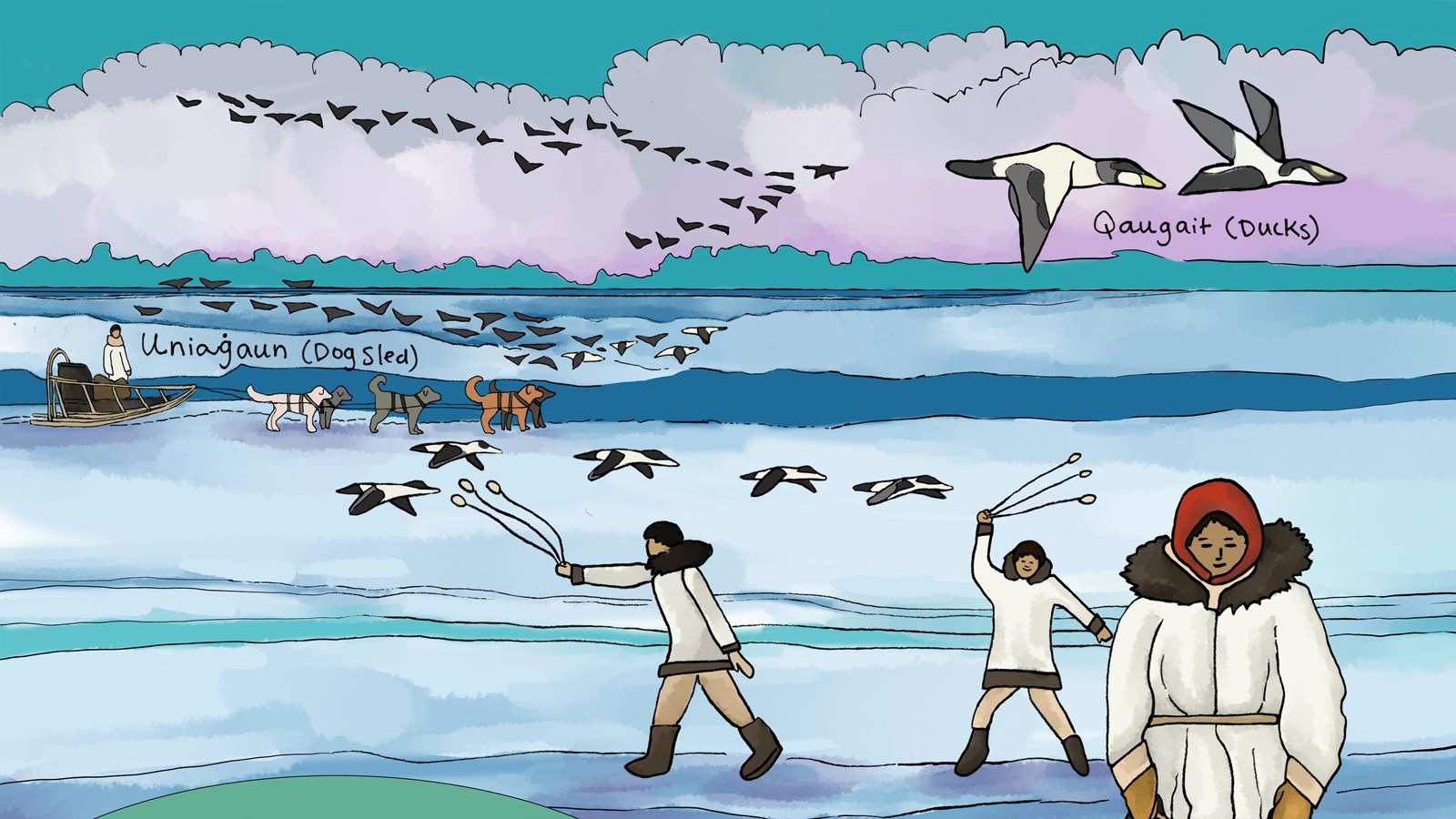Last updated: October 16, 2024
Place
Birnirk National Historic Landmark

Original Artwork by Kristin Link Illustrations and modified by NPS for use on this website.
Click HERE to view the full resolution colorized rendering featured above. Learn more on our NHLs of Alaska Coloring Book page.
Birnirk Life on the Arctic Coast
The Birnirk National Historic Landmark (known locally as Piġniq) sits on the Chukchi Sea coast near Utqiagvik (Barrow), Alaska. Piġniq is Iñupiaq for ‘joint’ or ‘articulation’ and describes the lagoon landform of the archaeological district. The technology that developed at this site (and other Birnirk tradition sites) supported rapid population expansion across the arctic regions of North America and Greenland.
The landmark is made up of a series of around 20 mounds on beach ridges. The mounds reach up to 14-feet tall and are dimpled with the sunken remains of house ruins and cache pits. The mounds were formed by the construction of new houses on top of the ruins of older structures over hundreds of years.
The population at the Birnirk site (Piġniq) was small, perhaps two or three houses during any one occupation. The houses at the site were square and about 12-feet wide. Driftwood and whalebones framed the walls and roofs, and the roofs were covered with sod. The entryways were below the level of the plank floor in order to trap heat in the home.
Since people lived at the Birnirk site (Piġniq) in ancient times, the decline in sea level left behind a series of ridges that were the former gravel shorelines. Recently, as sea level is on the rise, much of the archeology has eroded into the Elson Lagoon alongside the site.
During the Birnirk period, seals, fish, birds, caribou, and smaller land mammals were the primary animal resources. Whales were rarely captured. Artifacts found at Birnirk (Piġniq) were used for home life, hunting, fishing, and travel. A significant find at the Birnirk National Historic Landmark (Piġniq) is the remnants of a 1,000-year-old umiak. Some of the parts still have decorative ivory inlays and baleen lashing. Boats made from wood and animal parts are extremely rare in the archaeological record. Other items uncovered at the site include:
- Toboggans for winter and summer travel
- Stone lamps for light and heat
- Ceramic container fragments
- Engraving tools
- Chipped stone tools
- Ground slate tools
- Carved bone tools
- Harpoon parts
- Remnants of sealskin floats attached to harpoon lines
- Atlatl (throwing board) parts
- Caribou antler arrow points
- Bow and arrow parts
- Fishing leisters
- Bolas
- Bird darts
The Birnirk Archeological Tradition at Point Barrow
The Birnirk tradition is the earliest instance of modern Iñupiat culture in northern Alaska. This tradition lasted from about 1500 - 1000 years ago (500 AD to 900 AD). The Birnirk National Historic Landmark (Piġniq) is the type-site for this archeological tradition. Artifacts from a type-site serve as the prime example for particular archeological traditions (types and styles of tools). The collections from the Birnirk site (Piġniq) are used to compare and identify artifacts from other sites. The Birnirk archeological tradition is found from the Russian Far East to Alaska, and similar stone tools have been found in northern Canada.
The Birnirk tradition is considered the ancestor of the Thule archeological tradition, which continued to become today’s Northern Alaskan Iñupiat. The Thule archaeological tradition (from around 900 – 600 years ago) was more focused on whaling. Understanding the developments that took place during the Birnirk period helps researchers explain the common languages and cultures of Iñupiaq-speakers in northern Alaska and Canada.
Early Arctic Expeditions and Archeological Research
The first International Polar Year research program began in 1881. Army Lieutenant Patrick Henry Ray led the research station at Point Barrow. Ethnographic reports from this program, written by John Murdoch, were the first to describe the Birnirk site (Piġniq) to the western world.
Stefánsson Vilhájalmer was an early 20th century Canadian anthropologists, who led a one-day excavation of one of the mound features in 1912. He named the site Birnirk – a distortion of the Inupiat name Piġniq. Archeological excavation in the Arctic was difficult for Vilhajalmer, so after 1912, he began buying artifacts from local residents.
Archeological excavations at the site continued again in the 1930s and 1950s by researchers from Harvard University. Unfortunately, thorough study of the collections were never completed and reports of the research were brief (Wilbert Carter’s reports to the Office of Naval Research in the 1950s and 1960s).
Additional Information
More National Historic Landmarks in Alaska
“The Stefansson-Anderson Arctic Expedition of the American Museum: Preliminary Ethnological Report”, by Vilhjalmer Stefansson. Anthropological Papers of the American Museum of Natural History, Vol. 14, Part 1. New York, 1914.
“Archaeology of the Bering Sea Regions”, by Henry B. Collins. Proceedings of the Fifth Pacific Science Congress, Canada, 1933. Vol. IV, pp. 2825-2839. 1934.
“Eskimo Prehistory in the Vicinity of Point Barrow, Alaska”, by James A. Ford. Anthropological Papers of the American Museum of Natural History, Vol. 47. New York, 1959.
Arctic Area, Indigenous Period. By Henry B. Collins, Mexico, 1954.
My Life with the Eskimo. By Vilhjalmer Stefansson. New York, 1913.
The Friendly Arctic. By Vilhjalmer Stefansson. New York, 1921.
“Harpoons and Darts in the Stefansson Collection”, by Clark Wissle. Anthropological Papers of the American Museum of Natural History. Vol. 14, Part 2. New York, 1916.
“Ancient boat bits estimated to be 1,000 years old”, by Mike Dunham. Anchorage Daily News. Page A3, December 13, 2012.
